Goaltenders Lorne “Gump” Worsley and Johnny Bower had a lot in common. Both made their NHL debuts with the New York Rangers in the 1950s, both have earned multiple Vezina Trophies, both are members of the NHL Hall of Fame and both played into their 40s and won four Stanley Cups during their long playing careers. And of course both also had to leave New York to achieve their future success.
Gump Worsley was one of the most beloved characters to ever don a Rangers sweater. The Montreal native was born in May 1929 and began his hockey journey in 1946 with the Ranger-sponsored Verdun Cyclones of the QJHL, where he faced other soon-to-be NHL icons such as Bernie Geoffrion, Jean Beliveau as well as Jacques Plante.
Worsley, who was tagged with the nickname “Gump” thanks to his childhood resemblance to the cartoon character “Andy Gump,” was invited to the Rangers training camp in 1949 and assigned to the New York Rovers of the EAHL. He also saw action with the New Haven Ramblers of the AHL that season, appearing in two games and winning both of them. But it was during a Rover road trip that Worsley’s apprehension about flying grew into all out terror. The team was returning home from Milwaukee when one of the engines of their twin engine plane caught fire, forcing the pilot to make an emergency landing. Thankfully there were no injuries, but Gumper never overcame his fear after that.
In 1950-51 Worsley turned pro with the St. Paul Saints of the USHL where he was named Rookie of the Year and won the Charlie Gardiner Award as the circuit’s top netminder. He was then moved to the Saskatoon Quakers of the PCHL where he once again excelled.
The beginning of Gump’s NHL career was like a roller coaster ride with more than a few peaks and valleys along the way. He began the 1952-53 season with the Rangers subbing for the injured Chuck Rayner, making his NHL debut on opening night, October 9, 1952 in a 5-3 loss in Detroit. He stayed with the Rangers until mid-November while Rayner worked himself into shape. Gumper was then sent back to Saskatoon, but recalled a few weeks later when Rayner severely injured his knee. The twenty-three year old netminder wound up playing fifty games for the sixth place Rangers and was awarded the Calder Trophy as the NHL’s top rookie despite posting a 13-29-8 record for the defensively challenged Blueshirts.
But during the offseason the Rangers acquired veteran minor-league goaltender Johnny Bower from the Cleveland Barons of the AHL, in exchange for cash, goalie Emile Francis and forward Neil Strain, and Gumper once again found himself in the minors, this time in Vancouver of the WHL. The official party line at the time was that Rangers management feared that Worsley at 5-foot-7 and 180-pounds was too small to withstand the rigors of a full NHL season and that Bower at 5-foot-11, 189-pounds would be a sturdier option. But of course there was more to it than that.
“I was playing In Saskatoon in ’52-53 when Charlie Rayner got hurt and they called me up,” Gump told author Dick Irvin for his book, “In the Crease.” “He screwed up his knee and never played again. I played the last fifty games and won the rookie of the year. The next year I asked for a $500 raise and ended up in Vancouver. Everybody thinks Johnny Bower beat me out of a job, but it had to be the money. The next year, Camille Henry won the rookie award with the Rangers and he asked for a $500 raise. I got news for you: He ended up in Providence for most of the year.”
Bower, who had toiled for eight seasons in the minors, winning numerous awards and leading his teams to three league championships, finally got a crack at the NHL in 1953 at age twenty-nine.
The Saskatchewan native was believed to be born in November, 1924, but his exact age would remain a question for many years. At 15, he lied about his age to enlist in the Canadien Army and was stationed in England during World War II.
He was discharged in 1943 due to rheumatoid arthritis in his hands. He then played junior hockey with the Prince Albert Black Hawks of the SJHL and turned pro with the Cleveland Barons of the AHL in 1945.
While with the Barons, Johnny who had changed his last name from Kiszkan to Bower to make it easier for sportswriters, was scouted by the Rangers’ Carson Cooper, who told everyone that Bower belonged in the NHL.
Johnny had a great rookie season for the fifth-place Rangers, playing all 70 games and recording five shutouts and a 2.60 GAA, the lowest average by any Rangers goaltender in the previous 14 seasons.
While in New York, Johnny was mentored by Chuck Rayner, who taught him the fine art of the poke check. He was popular with the press, who called him the “Veteran Rookie,” as well as Ranger fans, who always loved their goalies, winning the Frank Boucher Trophy as the most popular Blueshirt as voted by the members of the Rangers Fan Club.
“Bower’s a good goalie. I don’t think there was much of a choice between us in training camp,” Worsley once told reporters. “He got the call and has done fine. He’s been everything the Rangers expected.”
Bower and Gump eventually wound up being good friends, wishing each other good luck before games and going on cruises together with their wives after retirement.
Legendary hocky writer Stan Fischler remembers Bower’s time with the Rangers very well. “The Indestructible Bower finally made it and was commendable with a 2.60 Goals against average in 1953-54. He deserved to be back and got screwed; no more no less. Gump, of course, got screwed a year earlier.”
Worsley had an outstanding season for Vancouver in 1953-54 earning league MVP honors and finishing with the best goals-against average in the WHL.
The next season Gump had a better camp and Johnny was sent to the Rangers affiliate in Vancouver but played in seven more games for the Blueshirts over the next two seasons filling in for the injured Worsley.
“My dad was not a complainer,” recalled Bower’s son John Jr.. “ I’m sure deep down he was disappointed that they didn’t give him more of a chance and keep him up but the league was different back then, the owners ran things and the players didn’t have much to say about anything. But he never gave up because he loved the game so much.”
Worsley came back strong. . On January 19, 1955 he posted a 2-0 shutout against the powerful Detroit Red Wings stopping 51 shots, which is believed to be the most saves mad by any Ranger goalkeeper in a shutout, to that point.
The blanking came during one of the best stretches in Worsley’s Ranger career when he allowed only eight goals in a six-game span that also included a scoreless tie and a 2-0 shutout, both against the Bruins.
Quotable and always quick with a quip, Gumper was a favorite of the press as well as the fans. Despite the fact that the Rangers only made the playoffs four times in Gump’s ten seasons on Broadway, he was recognized as one of the top netminders in the league. In 1955-56 he played every minute of every game, becoming the last Ranger goaltender to do so. He also set a team record with 32 victories which stood until Ed Giacomin racked up 36 wins in 1967-68. He led the NHL in games and minutes played in 1962-63 and played in two All-Star games while with the Blueshirts. Worsley also was selected as the Rangers MVP in 1960-61 and 1962-63 and given the Frank Boucher Trophy as the most popular Ranger in 1955-56 and again in 1962-63.
During his time in New York, Worsley was often asked which team gave him the most trouble. His response was always an emphatic, “The Rangers!” and for good reason. Worsley was one of the few bright spots on some mediocre Ranger teams during the 1950s. He was a warrior, his main accomplishment was surviving ten long seasons in the Blueshirts shooting gallery. Gump took a beating in the Rangers net, having to be carried off the ice a number of times. His most serious injury as a Ranger occurred on February 17, 1960 when Chicago’s Bobby Hull accidentally skated over his hand, severing two tendons. Worsley required surgery and missed the rest of the season.
Gump played for seven coaches while with the Rangers, including Phil Watson, who had also been his coach while with the Rovers.
The Blueshirts made the playoffs three times with Watson behind the bench but it was clear that “Fiery Phil” didn’t like Worsley and as far as Gump was concerned, the feeling was mutual. Watson was the kind of coach who would take all the credit for a victory, but blame a loss on the players. Gump was one of Watson’s favorite whipping boys, constantly getting on him about his “beer belly,” to which Worsley calmly replied, “Beer is the poor man’s champagne. I’m strictly a VO [rye] man.”
While Worsley was not exactly svelte, he was extremely agile. He could scramble back to his feet very quickly and emphatically swat rebounds out of harm’s way with a quick, one-handed golf swing.








